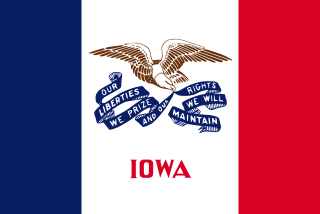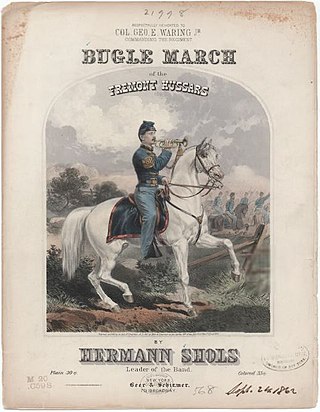Related Research Articles
The 3rd Wisconsin Cavalry Regiment was a volunteer cavalry regiment that served in the Union Army during the American Civil War.

The 3rd Illinois Cavalry Regiment was a cavalry regiment that served in the Union Army during the American Civil War. It fought at such battles as Pea Ridge, Sherman's Yazoo campaign, the battle of Port Gibson, and the siege of Vicksburg.

The 4th Iowa Cavalry Regiment was a cavalry regiment that served in the Union Army during the American Civil War.
8th Missouri Cavalry Regiment was a cavalry unit from Missouri that served in the Union Army during the American Civil War. The regiment was formed between 6 August and 15 September 1862. The regiment fought at Prairie Grove and Van Buren in 1862. The unit participated in Frederick Steele's expedition to Little Rock in 1863, fighting at Brownsville, Bayou Meto, and Bayou Fourche. From 1863 to 1865, the regiment remained in Arkansas, going on expeditions to suppress Confederate raiders and other occupation duties. The unit was mustered out of service on 20 July 1865. In January 1863, the regiment committed what has become known as the Huntsville Massacre.
The 7th Kentucky Infantry Regiment was an infantry regiment that served in the Union Army during the American Civil War.
The 6th Kentucky Cavalry Regiment was a cavalry regiment that served in the Union Army during the American Civil War.
The 5th Kansas Volunteer Cavalry Regiment was a cavalry regiment that served in the Union Army during the American Civil War.
The 9th Kansas Cavalry Regiment was a cavalry regiment that served in the Union Army during the American Civil War.
The 11th Kansas Volunteer Cavalry Regiment was a cavalry regiment that served in the Union Army during the American Civil War.
The 14th Kansas Cavalry Regiment was a cavalry regiment that served in the Union Army during the American Civil War.
The 2nd Regiment Colorado Cavalry was a cavalry regiment that served in the Union Army during the American Civil War.

The 4th Missouri Cavalry Regiment, also known as the Fremont Hussars, was a cavalry regiment that served in the Union Army during the American Civil War. Elements of the regiment fought at Pea Ridge, Whitney's Lane, Little Blue River, Byram's Ford, Westport, Marais des Cygnes, Marmiton River, and Mine Creek. Company C served at Iuka and Corinth while Company F was at Raymond, Jackson, Champion Hill, and Vicksburg.
The 2nd Regiment Arkansas Volunteer Cavalry (1862–1865) was a cavalry regiment that served in the Union Army during the American Civil War. Although Arkansas joined the Confederate States of America in 1861, not all of its citizens supported secession. Arkansas formed some 48 infantry regiments to serve in the Confederate Army, but also formed another 11 regiments that served in the Union Army.
The 6th Missouri Cavalry Regiment was a cavalry regiment that served in the Union Army during the American Civil War. The regiment was organized in February 1862 by merging three independent cavalry battalions.
The 2nd Missouri Cavalry Regiment, also known officially as Merrill's Horse, was a cavalry regiment that served in the Union Army during the American Civil War. The regiment was one of only a handful of Missouri regiments to be officially named as well as numbered.

The 3rd Missouri Cavalry Regiment was a cavalry regiment that served in the Union Army during the American Civil War principally in Missouri and Arkansas.
The 3rd Regiment Arkansas Volunteer Cavalry (1864–1865) was a cavalry regiment that served in the Union Army during the American Civil War. Although Arkansas joined the Confederate States of America in 1861, not all of its citizens supported secession. Arkansas formed 11 regiments that served in the Union Army.
The 7th Regiment Indiana Cavalry was a cavalry regiment that served in the Union Army during the American Civil War.

The 1st Missouri Volunteer Cavalry Regiment was a cavalry regiment with three battalions that served in the Union Army during the American Civil War from 1861 to 1865.
1st Indiana Cavalry Regiment, also known as the 28th Regiment of Volunteers was a cavalry unit that served in the Union Army during the American Civil War. Organized in August 1861, it did most of its fighting in the state of Arkansas. The regiment was in action at Cotton Plant, Helena, Bayou Fourche, Pine Bluff, Mount Elba, and Marks' Mills. One company was detached and fought in several actions in the Vicksburg campaign. The regiment was discharged in June 1865.
References
- Dyer, Frederick H. A Compendium of the War of the Rebellion (Des Moines, IA: Dyer Pub. Co.), 1908.
- History of the State of Nebraska (Chicago: The Western Historical Company), 1882.
- Attribution
 This article contains text from a text now in the public domain : Dyer, Frederick H. (1908). A Compendium of the War of the Rebellion. Des Moines, IA: Dyer Publishing Co.
This article contains text from a text now in the public domain : Dyer, Frederick H. (1908). A Compendium of the War of the Rebellion. Des Moines, IA: Dyer Publishing Co.